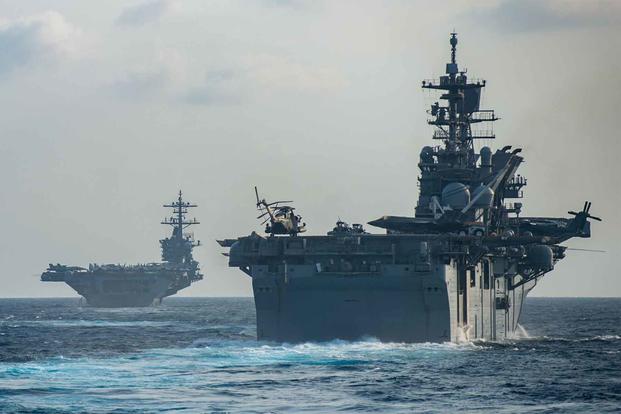The U.S. has the number of aircraft carriers it needs to meet requirements across the globe — unless “additional challenges show themselves,” the four-star admiral nominated to oversee military operations in the Asia-Pacific region said.
The 11 aircraft carriers in the military’s arsenal — as currently required by law — are what the force needs, Adm. John Aquilino said during a Tuesday Senate confirmation hearing. Aquilino has been nominated to lead U.S. Indo-Pacific Command.
Aquilino was asked by Sen. Roger Wicker, R-Miss., whether the Navy has enough carriers to deter China in the Pacific while still operating in the Middle East and elsewhere.
“We’ve complied to the law [with] 11, but is that enough though?” Wicker asked Aquilino. “Just tell us — we need to know. We can change the law of the land if we get enough votes.”
Acquilino said carrier strike groups are a tremendous form of deterrence, but demurred on saying the Navy needed more.
“I think currently that the size of that force is correct unless additional challenges show themselves,” he said.
Navy aircraft carriers are in high demand across the globe, but the service faced criticism from Congress when leaders in 2019 proposed retiring one early to invest in new technologies. USNI News reported this month that Pentagon leaders are again considering a reduced carrier force structure as part of its upcoming 2022 budget submission to Congress.
Resistance from lawmakers is likely. Wicker released a statement Monday calling for a bigger Navy in response to growing presence at sea from Russia and China. He urged the Biden administration to embrace a military plan released under President Donald Trump to increase the fleet to 405 manned Navy ships by 2051.
“If we do not ramp up shipbuilding dramatically, it will be more and more difficult to prevent a future conflict with our adversaries,” Wicker wrote.
Bryan McGrath, a retired surface officer and naval consultant, said while he has great respect for Aquilino, he believes the admiral is wrong to think 11 carriers are enough for the Navy to carry out its global requirements. McGrath cited ongoing trouble with carrier maintenance, readiness woes, and the need for extended or double-pump deployments that have weighed on the force.
The 11-carrier requirement was made law at about the same time as the Navy’s 2007 maritime strategy, which enshrined a “two-hub” presence in the Western Pacific and Persian Gulf or Indian Ocean. Eleven is the minimum necessary carrier count to support the two hubs with continuous coverage, McGrath added, given maintenance and transit-time requirements.
Whenever two carriers are needed in one of those hubs though — which happened last year in response to Iranian threats and again just last month in the South China Sea — “the brittle relationship between that number of carriers and that number of hubs comes into stark relief,” he added.
And today, the U.S. is also now dealing with a resurgence from Russia in the Mediterranean and North Atlantic, McGrath said.
“The nation cannot ignore Europe as a theater for carrier operations, and in fact, it hasn’t,” he said. “And so for several years, we’ve taken the minimum number of carriers necessary to fill two hubs continuously and attempted to time share in a third, even as we desired multiple carriers in one or more of those hubs in this period.”
McGrath made the case in 2015 for a 16-carrier Navy. That many carriers could support continuous coverage of “three hubs indefinitely,” he wrote, “with little or no risk of gap.” He said he stands by that argument, adding, “if anything, today’s security environment is more pressing than when I wrote these words in 2015.”
Last week, Adm. Phil Davidson, who currently leads Indo-Pacific Command, told lawmakers there’s no substitute for having an aircraft carrier in the Pacific to counter China’s growing presence in the region.
The Navy is also still considering reactivating another numbered fleet in the Western Pacific, Davidson said. The Japan-based U.S. Seventh Fleet currently oversees Navy operations all the way from India down to Antarctica and up past Japan to the Kuril Islands.
— Gina Harkins can be reached at gina.harkins@military.com. Follow her on Twitter @ginaaharkins.

